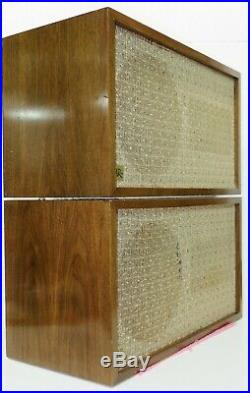
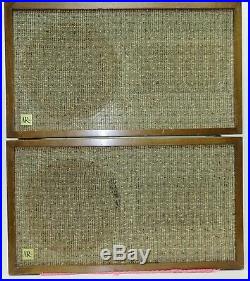
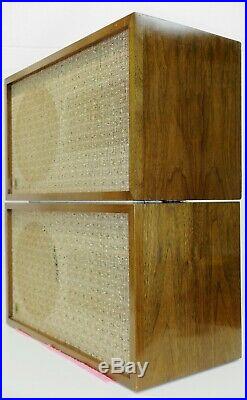
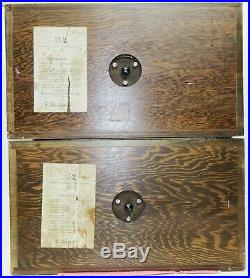

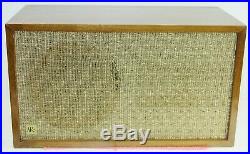
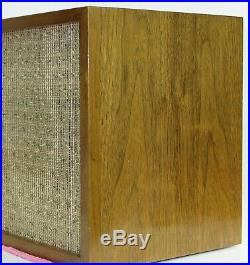
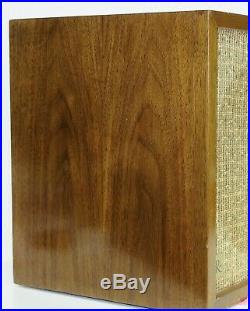

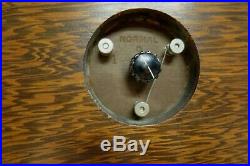

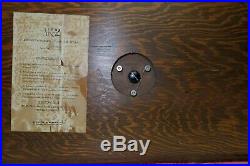

Acoustic Research AR-2, Loudspeaker Pair, Lacquered-Walnut, SN B20253-B20254, Highly Collectible and Quite Rare in this finish. AR-2, Lacquered-Walnut Cabinets, SNs B 20253 and B 20254, 1958. This pair of Acoustic Research AR-2 speakers is in excellent electro-mechanical condition, very good-to-excellent physical condition. The speakers have excellent sound. The woofers produce clean, deep bass with no audible distortion, even at moderately high listening levels, and the tweeters are also fine. The level-control potentiometers are the earlier Allen-Bradley type that are not susceptible to the corrosion issue that plagued the later AR speakers with loss-contact, drop-outs and so forth. These speakers do not have any of that problem, and the controls work for most of the control range without any issues except for very slight drop outs at certain positions. These speakers also have oil-filled surplus mil-spec crossover capacitors, so the crossover. Values are not susceptible to variation or change. It is remarkable that these speakers, over 60 years old, sound as though they were brand new and just out of the box. The sound is characteristically AR-2, which is to say that the bass is extremely solid, clean and clear, and the treble is well-defined and smooth without any harshness. There is no sign of dried-out woofer skiver, as this would result in loss of bass output. “Bright” they are not, of course, but this was always a characteristic of this speaker with its smooth, laid-back treble quality. “Quality” of the treble was considered more important than “quantity, ” so the speaker’s high end was sacrificed slightly in order to have a smooth, uniform output across the entire midrange and lower treble. The AR-2 actually “images” extremely well, too, insofar as the tweeters don’t have quite the dispersion the later “dome” AR speakers exhibit, but the AR family resemblance is definitely there. The most beautiful thing about these speakers is the cabinet finish itself. These were finished (on three sides). The cabinets on these AR-2s are generally in excellent condition. They are finished in a beautiful lacquered-walnut, with nearly the equal of a lacquered-walnut steinway piano. AR’s cabinet-makers and finishers at the time made the lacquer finishes smooth and flawless, and one must see this finish up close to appreciate the beautiful finish that was applied. There are a few small, incidental nicks and scratches, but very few. One side of the cabinet is finished in clear-lacquer-over-pine surface, as the earliest AR-2s and AR-2a speakers were veneer finished on three sides only. The reason for this was the fact that the two 5-inch tweeters were horizontally mounted, and for best sound, the speaker needed to be placed horizontally on a bookshelf or a table. It was therefore decided that there was no need to have expensive veneer on all sides since the speaker’s bottom would not show, and this could help keep the cost of the speaker in a reasonable range. The grills are relatively clean and very original in appearance, tight and straight, but one grill has a tear in it where a child or someone apparently pushed in on the grill material, causing a slight tear. Someone accomplished with a needle and thread could easily pull this back together to make it nearly as good as new. This is the only thing that detracts from the originality of these speakers. The grills have never been removed from these speakers, and there is no reason to do so. The logos are bright and new in appearance and do not reflect any oxidation. These speakers have been stored in air-conditioned, low-humidity space for the past 25-30 years, and there has been very little deterioration over time. The AR-2 General Description. The AR-2, introduced in 1957, was the second speaker developed by Acoustic Research to become the first low-cost speaker to use the patented acoustic-suspension design. When introduced, it was felt that the AR-2 could easily be compared with any speaker system, even some that cost several times as much as the AR-2. The AR-2 had bass response that approached the AR-1, and gave up only about -octave in deep bass when compared to the larger and more expensive AR-1 model. This was accomplished at a retail price of less than one-half the cost of the AR-1. This speaker was also check-rated by Consumer Reports and placed in the top group of speakers tested at the time, surpassing both the KLH Four and the KLH Six in deep-bass extension and performance. The AR-2 is a sealed, acoustic-suspension system, 13.5″ x 11″ x 24 with a 10-inch acoustic suspension woofer using a cast-aluminum frame and an Alnico-5 ring magnet with a structure weight of 3.3 lbs. The system resonance frequency was 58 Hz, so the system was down approximately 12 dB at 29 Hz, and 3 dB down at approximately 48-50 Hz. Very respectable bass extension. Harmonic distortion was very low at all frequencies, such that the AR-2 could cleanly reproduce fundamental frequency tones that most speakers of the day were incapable of reproducing. At 30 Hz, an AR-2 produced less than 8% harmonic distortion with an input power of 10 watts rms (quite loud at a steady-state level). For the high-frequency section, the system uses two 5-inch special cone-type tweeters, mounted at a cast enclosure with horizontal angle to splay the output off-axis. The tweeters are treated with a butyl-rubber rim treatment, and fiberglass damping pads were inserted under the cones themselves to dampen output and to keep the overall response very clean and uniform out to approximately 14-15 kHz, with drop-off in output beyond that point. The crossover in the AR-2 was a 2-way, LCR-type network with a crossover frequency of 2000 Hz. There was some built-in equalization designed into the crossover for the tweeters to extend and smoothen the high-frequency performance of the 5-inch tweeters. Dispersion was over a 90 horizontal angle, thus the need to mount the speaker horizontally for best performance. Recommended amplifier input power was a minimum of 20-40 watts rms. The item “Acoustic Research AR-2, Loudspeaker Pair, Lacquered-Walnut, SN B 20253-B 20254″ is in sale since Sunday, June 2, 2019. This item is in the category “Consumer Electronics\Vintage Electronics\Vintage Audio & Video\Vintage Speakers”. The seller is “acoustic-research-inc” and is located in High Point, North Carolina. This item can be shipped worldwide.
- Model: AR-2
- Modified Item: No
- Country/Region of Manufacture: United States
- Custom Bundle: No
- MPN: Acoustic Research Model AR-2
- Brand: Acoustic Research
